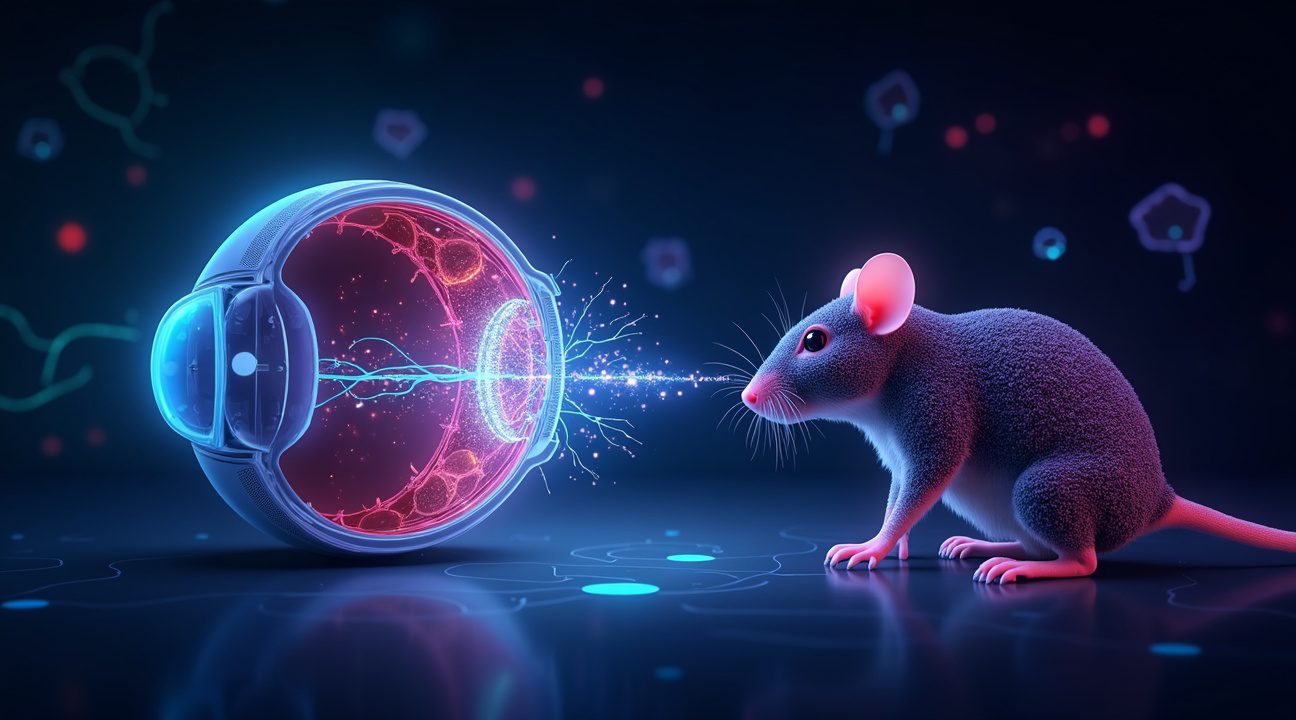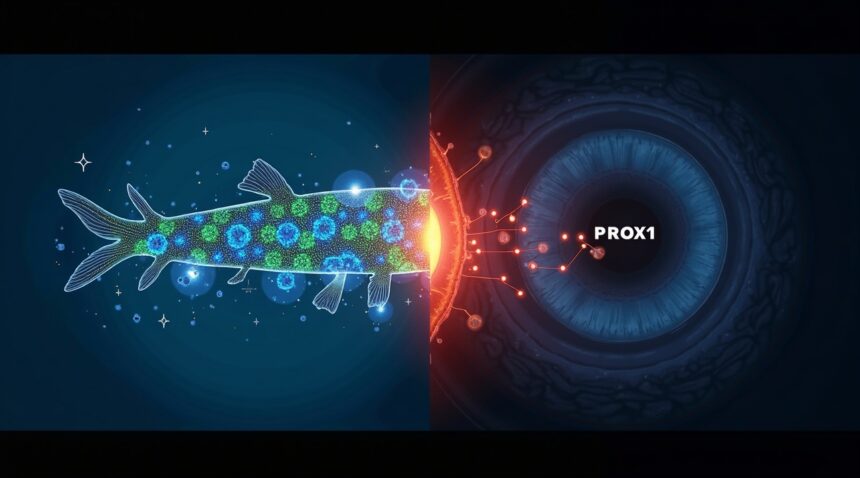Scientists from the Korean Advanced Institute of Science and Technology have made a pivotal discovery around retinal regeneration, identifying a protein, PROX1, as a critical barrier to natural vision repair in mammals.
Breakthrough in Vision Regeneration
Researchers at the Korean Advanced Institute of Science and Technology (KAIST) have discovered that a protein known as PROX1 functions as a molecular “brake” that prevents mammals from regenerating damaged retinal nerve cells. Although fish and amphibians naturally possess the ability to restore lost vision, mammals typically do not. This discovery suggests that mammals may still hold the genetic instructions necessary for vision repair—however, these remain switched off under normal conditions.
Groundbreaking Experiment in Mice
Experimental procedures involved selectively blocking the PROX1 protein in laboratory mice. The result was the regrowth of functional retinal tissue. Most notably, the mice retained restored vision for more than six months, marking the longest recorded duration of vision restoration in mammals through regenerative means. This finding is reshaping our understanding of what is possible in mammalian vision science.
Key Takeaways
- PROX1 protein blocks natural vision regeneration – This molecular gatekeeper prevents mammals from regrowing damaged retinal cells, a stark contrast to species capable of natural sight restoration, like fish and amphibians.
- Blocking PROX1 restored vision in mice for over 6 months – The sustained regeneration of retinal nerve cells represents an unprecedented success in mammalian models.
- CLZ001 drug targets PROX1 for human treatment – A new compound, CLZ001, is being developed to inhibit PROX1 and is currently undergoing preclinical evaluation. Human clinical trials are expected to begin in 2028.
- Multiple eye diseases could benefit from this approach – Conditions such as macular degeneration, diabetic retinopathy, and glaucoma could potentially be treated using this regenerative methodology.
- 200–300 million people globally could benefit – This figure represents individuals who currently suffer from severe retinopathies or irreversible retinal damage with no available restorative treatment options.
Future Implications
The discovery opens new paths forward in ophthalmic therapy, especially as researchers edge closer to initiating human trials. If compounds like CLZ001 prove effective in humans, the potential for vision restoration among millions is significant and could represent a revolution in how degenerative eye conditions are treated.
Discovery of PROX1: The Molecular Gatekeeper Blocking Vision Regeneration
Scientists at the Korean Advanced Institute of Science and Technology (KAIST) have identified a crucial protein that’s been standing in the way of vision recovery for millions of years. PROX1 acts as a molecular gatekeeper, actively preventing mammalian retinas from regenerating damaged nerve cells after injury or disease.
The Protein That Blocks Natural Healing
PROX1 serves as nature’s brake system for retinal regeneration in mammals. While other animals can naturally regrow damaged eye tissue, this protein keeps mammalian retinas locked in a non-regenerative state. The Korean research team discovered that PROX1 actively suppresses the cellular machinery needed for nerve cell regeneration, explaining why humans and other mammals lose vision permanently after retinal damage.
When researchers blocked PROX1 in laboratory mice, something remarkable happened. The animals began regenerating functional retinal nerve cells, restoring vision that lasted for over six months—the longest duration ever recorded for mammalian retinal regeneration. This breakthrough suggests that mammals possess the genetic blueprint for vision repair, but PROX1 keeps these healing mechanisms switched off.
Long-Term Vision Restoration Success
The implications extend far beyond basic science. Mice treated with PROX1 inhibition regained functional vision cells that had been lost through disease, demonstrating that this approach can reverse established damage rather than simply prevent it. The sustained nature of the recovery—lasting over six months—indicates that blocking PROX1 doesn’t just trigger temporary cellular activity but establishes lasting regenerative processes.
This discovery challenges previous assumptions about permanent vision loss. Scientists have long wondered why researchers find such varying regenerative abilities across different species, and PROX1 provides a clear answer for mammalian limitations.
The research opens new possibilities for treating conditions like:
- Macular degeneration
- Diabetic retinopathy
- Glaucoma
Rather than focusing solely on preventing further damage, future treatments might target PROX1 to activate the body’s dormant regenerative capabilities. Early results suggest that mammals have retained the cellular machinery for retinal repair throughout evolution, but PROX1 keeps these systems permanently disabled under normal circumstances.
Understanding PROX1’s role as a molecular gatekeeper represents a fundamental shift in how scientists approach vision restoration. Instead of trying to replace damaged cells with artificial implants or transplanted tissue, researchers can now explore ways to convince the body to rebuild its own visual system naturally.

Why Fish Can Regrow Eyes But Humans Cannot
Zebrafish possess an extraordinary ability that humans can only dream of – they can completely regrow damaged retinal tissue. This remarkable regenerative power stems from specialized cells called Muller glia, which act as the body’s natural repair crew for vision-related damage. When injury occurs, these cells immediately spring into action, transforming themselves into progenitor cells that can replace lost neurons and restore sight.
The Regenerative Process in Lower Vertebrates
Amphibians and fish have retained evolutionary mechanisms that mammals have largely lost over time. I find it fascinating how researchers find these creatures can activate their Muller glia cells almost instantly after retinal damage occurs. These transformed cells don’t just patch up minor injuries – they can rebuild entire sections of damaged retinal tissue, effectively restoring full vision capabilities.
The process works like a sophisticated biological assembly line:
- Muller glia cells first detect retinal damage through chemical signals.
- They then rapidly change their cellular programming to become retinal progenitor cells.
- These progenitor cells multiply and differentiate into various types of neurons needed for vision, including:
- Photoreceptors that detect light.
- Ganglion cells that transmit visual information to the brain.
What Blocks Regeneration in Humans
Mammals face a significant roadblock in retinal regeneration due to proteins like PROX1, which essentially lock Muller glia cells in their supportive role. This protein acts like a molecular brake, preventing these cells from transforming into the regenerative progenitor cells that could repair damaged retinas. While this suppression may have evolved to maintain retinal stability in mammals with longer lifespans, it comes at the cost of regenerative ability.
The stakes couldn’t be higher for finding solutions. Over 300 million people worldwide face the risk of blindness from retina-related diseases, making this research incredibly urgent. Current scientific efforts concentrate on identifying ways to temporarily override these molecular brakes, essentially reactivating the dormant regenerative pathways that still exist in mammalian cells but remain suppressed.
Scientists have discovered that breakthrough research can sometimes unlock these hidden capabilities. Recent experiments show promise in temporarily silencing PROX1 and other inhibitory proteins, allowing human Muller glia cells to begin the transformation process that zebrafish perform naturally. These findings suggest that humans haven’t completely lost their regenerative potential – it’s simply been switched off by evolutionary pressures that prioritized retinal stability over repair capability.

Breakthrough Drug CLZ001 Shows Promise for Human Vision Restoration
Scientists at KAIST have developed CLZ001, a groundbreaking compound that represents a fundamental shift in how researchers approach vision loss treatment. This PROX1-neutralizing drug works by blocking the PROX1 protein, which normally prevents retinal cells from regenerating after damage.
How CLZ001 Targets the Root Cause of Vision Loss
The innovative mechanism behind CLZ001 centers on neutralizing PROX1, a protein that essentially acts as a biological brake on retinal regeneration. When this protein is blocked, the body’s natural ability to regrow damaged vision cells is unleashed. This approach is particularly exciting because it addresses the fundamental problem rather than just managing symptoms.
Testing in mouse models has demonstrated remarkable results, with the compound successfully restoring vision in animals with retinal disease. The drug doesn’t just slow progression like current treatments — it actually reverses damage that has already occurred. This represents a paradigm shift from conventional therapies that focus primarily on preventing further deterioration.
Clinical Development Timeline and Global Impact
CLZ001 is currently advancing through preclinical studies, with human clinical trials scheduled to begin in 2028. This timeline reflects the careful approach required for developing treatments that could potentially restore sight to millions of people worldwide.
The therapeutic implications extend across multiple devastating eye conditions. Consider these major applications:
- Macular degeneration treatment, which affects over 196 million people globally
- Diabetic retinopathy intervention for the 146 million individuals currently impacted
- Glaucoma therapy addressing the needs of 76 million patients worldwide
- Broader retinal disease applications for various inherited and acquired conditions
What sets this PROX1-neutralizing antibody apart from existing treatments is its regenerative potential. Current standard-of-care options primarily slow disease progression, offering limited hope for patients who have already experienced significant vision loss. CLZ001 could change that equation entirely.
The drug development process will involve rigorous safety and efficacy testing before reaching patients. However, the preclinical results suggest this compound could transform how doctors treat degenerative eye diseases. Just as scientists think they’ve uncovered mysteries in neuroscience, this vision research breakthrough demonstrates how understanding fundamental biological mechanisms can lead to revolutionary treatments.
For patients currently managing progressive vision loss, CLZ001 represents hope for actual restoration rather than just preservation. The compound’s ability to reactivate the body’s own regenerative processes could make the difference between managing decline and regaining sight.
Stem Cell Therapies and Retinal Organoids Enter Clinical Testing
Recent breakthroughs in scientific research have opened new pathways for vision restoration through advanced stem cell technologies. I’ve observed how researchers have identified human retinal stem cells (hNRSCs) that hold remarkable potential for treating degenerative eye diseases. These specialized cells can differentiate into various retinal cell types, offering hope for patients with conditions like macular degeneration and retinitis pigmentosa.
Laboratory studies using animal models have demonstrated promising results when scientists apply stem cell-based therapies to damaged retinal tissue. The treatments have successfully restored partial vision in test subjects, marking a significant step forward in regenerative medicine approaches. Building on these findings, researchers have developed genome-edited retinal organoid sheets that show improved integration capabilities with existing eye tissue.
Clinical Progress and Current Limitations
UC Davis has conducted groundbreaking trials focusing on retinitis pigmentosa patients, where stem cell injections produced encouraging outcomes. After six months of treatment, participants experienced halted vision loss, and some cases showed actual improvement in visual function. These results represent a crucial milestone in transitioning from laboratory research to human applications.
The development of retinal organoids has advanced significantly in preclinical and early clinical studies. Scientists create these three-dimensional tissue structures to better understand retinal development and test potential therapies. Gene therapy techniques combined with cell transplant methods are enhancing the precision and effectiveness of these treatments.
However, medical professionals maintain cautious optimism about current progress. The Malaysian Society of Ophthalmology emphasizes that labeling present stem cell therapies as definitive breakthroughs for human patients remains premature. Most research findings continue to exist in experimental stages, requiring extensive validation before becoming standard treatment options.
Cell transplant procedures face several challenges, including:
- Ensuring proper integration with existing retinal tissue
- Preventing immune rejection
- Addressing long-term safety concerns
- Establishing optimal dosing protocols
The complexity of retinal architecture demands precise placement and timing of therapeutic interventions.
Regenerative medicine approaches show tremendous promise, yet clinical trials must demonstrate consistent safety and efficacy across diverse patient populations. Researchers continue refining techniques to improve cell survival rates and functional outcomes. The transition from promising laboratory results to reliable clinical treatments requires rigorous testing and regulatory approval processes that can span several years.
Current studies focus on:
- Optimizing delivery methods
- Developing standardized protocols for stem cell preparation and administration
- Identifying the most suitable patient candidates
- Determining optimal treatment timing for maximum therapeutic benefit

Global Impact: 200-300 Million People Could Benefit from Vision Restoration
I find myself examining a staggering reality: over 200-300 million people across the globe currently live with serious retinopathies or vision loss stemming from irreversible retinal damage. This enormous population represents individuals whose sight cannot be restored through traditional treatments, leaving them dependent on assistive technologies and adaptive strategies.
The scale of this challenge grows more pronounced as our global population ages. Demographic shifts indicate that demand for regenerative therapies will surge dramatically over the coming decades. Unlike conventional approaches that focus on preserving existing vision, these emerging treatments promise to restore sight that was once considered permanently lost.
Current management strategies rely heavily on early detection protocols, which remain essential for preventing further deterioration. However, the limitations of these approaches become apparent when dealing with advanced retinal damage. Patients who missed early intervention windows or whose conditions progressed despite treatment find themselves with few viable options under existing medical frameworks.
Revolutionary Treatment Approaches
Regenerative drugs and cell-based therapies represent a fundamental shift in how medical professionals approach vision loss. These treatments work by repairing or replacing damaged retinal tissue rather than simply slowing its decline. Scientists have made remarkable progress in understanding how to activate the body’s natural repair mechanisms, much like recent breakthroughs in other fields. For instance, researchers have explored similar regenerative concepts in studies ranging from neurological discoveries to biological building blocks found in space exploration.
Clinical trials for these innovative therapies continue to expand, offering hope to millions who previously had no treatment options. Patients enrolled in these studies report varying degrees of visual improvement, from enhanced light perception to restored reading ability. The success stories emerging from research facilities worldwide demonstrate the transformative potential of regenerative medicine.
Cell-based approaches involve transplanting healthy retinal cells or stem cells into damaged areas, essentially rebuilding the eye’s visual processing capacity. Drug-based regenerative therapies work by stimulating the body’s own repair processes, encouraging existing cells to regenerate and form new functional tissue.
The quality of life improvements following successful vision restoration extend far beyond simple sight recovery. Patients regain independence in daily activities, experience reduced depression and anxiety, and often return to productive employment. Family relationships strengthen as individuals no longer require constant assistance for basic tasks.
Economic implications of widespread vision restoration prove equally significant. Healthcare systems currently spend billions annually supporting individuals with vision loss through disability payments, specialized services, and assistive technologies. Successful regenerative treatments could redirect these resources while simultaneously increasing productivity as more people return to active workforce participation.
The speed at which scientific discoveries translate from laboratory settings to clinical practice raises important ethical considerations. Patients desperate for treatment may pressure researchers to accelerate timelines, potentially compromising safety protocols. Balancing hope with realistic expectations becomes crucial as clinical trials progress through regulatory approval processes.
Access and affordability present additional challenges as these treatments move closer to market availability. Ensuring equitable distribution of regenerative therapies across different socioeconomic groups and geographic regions requires careful planning and policy development.
Technology integration continues to play a supporting role, with innovations like advanced transportation and adaptable robotics potentially enhancing patient access to specialized treatment centers. These developments could help overcome geographic barriers that currently limit many patients’ access to cutting-edge therapies.
Regulatory agencies face the complex task of balancing rapid approval processes with thorough safety evaluations. The pressure to expedite treatments for such a large affected population must be weighed against the need for comprehensive long-term safety data. International collaboration between research institutions accelerates progress while sharing the burden of extensive clinical testing requirements.
https://www.youtube.com/watch?v=wGQdFVBpCtw
Sources:
CBS News – New Research Shows Promise for Restoring Vision
Popular Mechanics – Scientists Find Switch to Restore Eyesight
ScienceDaily – Retinal Therapy Restore Vision
Live Science – New Cells Discovered Eye Restore Vision
SciTechDaily – Researchers Successfully Reverse Retinal Damage
PIE Magazine – Beyond Genetic Code: ARVO 2025
UC Davis Health – Can Stem Cells Restore Vision? Inside Promising Trial
CodeBlue by Galen Centre – Correcting Misleading Assertions: Stem Cell Breakthrough


